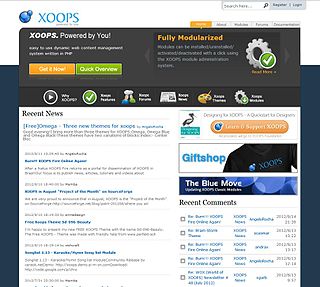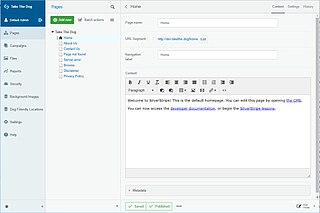
MediaWiki is free and open-source wiki software originally developed by Magnus Manske for use on Wikipedia on January 25, 2002, and further improved by Lee Daniel Crocker, after which it has been coordinated by the Wikimedia Foundation. It powers most websites hosted by the Foundation including Wikipedia, Wiktionary, Wikimedia Commons, Wikiquote, Meta-Wiki and Wikidata, which define a large part of the set requirements for the software.

Tiki Wiki CMS Groupware or simply Tiki, originally known as TikiWiki, is a free and open source Wiki-based content management system and online office suite written primarily in PHP and distributed under the GNU Lesser General Public License (LGPL-2.1-only) license. In addition to enabling websites and portals on the internet and on intranets and extranets, Tiki contains a number of collaboration features allowing it to operate as a Geospatial Content Management System (GeoCMS) and Groupware web application.
Web development is the work involved in developing a website for the Internet or an intranet. Web development can range from developing a simple single static page of plain text to complex web applications, electronic businesses, and social network services. A more comprehensive list of tasks to which Web development commonly refers, may include Web engineering, Web design, Web content development, client liaison, client-side/server-side scripting, Web server and network security configuration, and e-commerce development.

Textpattern is a free and open-source content management system (CMS) for PHP and MySQL. It was originally developed by Dean Allen and now developed by Team Textpattern. While it is typically listed among weblogging tools, its aim is to be a general-purpose content management system. The current stable version is Textpattern 4.8.8.

WebGUI is an open-source content management system written in Perl and released under the GNU General Public License.

XOOPS is a free open-source content management system (CMS), written in PHP. It uses a modular architecture allowing users to customize, update and theme their websites. XOOPS is released under the terms of the GNU General Public License (GPL) and is free to use, modify and redistribute.

Ruby on Rails is a server-side web application framework written in Ruby under the MIT License. Rails is a model–view–controller (MVC) framework, providing default structures for a database, a web service, and web pages. It encourages and facilitates the use of web standards such as JSON or XML for data transfer and HTML, CSS and JavaScript for user interfacing. In addition to MVC, Rails emphasizes the use of other well-known software engineering patterns and paradigms, including convention over configuration (CoC), don't repeat yourself (DRY), and the active record pattern.
Embedded Ruby is a templating system that embeds Ruby into a text document. It is often used to embed Ruby code in an HTML document, similar to ASP and JSP, and PHP and other server-side scripting languages. The templating system of eRuby combines Ruby code and plain text to provide flow control and variable substitution, thus making the combined code easier to maintain.

Silverstripe CMS is a free and open source content management system (CMS) and framework for creating and maintaining websites and web applications. It provides an out of the box web-based administration panel that enables users to make modifications to parts of the website, which includes a WYSIWYG website editor. The core of the software is Silverstripe Framework, a PHP Web application framework.
Haml is a templating system that is designed to avoid writing inline code in a web document and make the HTML cleaner. Haml gives you the flexibility to have some dynamic content in HTML. Similar to other template systems like eRuby, Haml also embeds some code that gets executed during runtime and generates HTML code in order to provide some dynamic content. In order to run Haml code, files need to have a .haml extension. These files are similar to .erb or .eRuby files, which also help embed Ruby code while developing a web application.

TYPO3 is a Web content management system (CMS) written in the programming language PHP. It can run on a variety of web servers, such as Apache, Nginx, or Internet Information Services (IIS), and on many operating systems, including Linux, Microsoft Windows, FreeBSD, macOS, and OS/2. It is free and open-source software released under the GNU General Public License version 2.

CMS Made Simple (CMSMS) is a free, open source (GPL) content management system (CMS) to provide developers, programmers and site owners a web-based development and administration area. In 2017 it won the CMS Critic annual award for Best Open Source Content Management.

Umbraco is an open-source content management system (CMS) platform for publishing content on the World Wide Web and intranets. It is written in C# and deployed on Microsoft based infrastructure. Since version 4.5, the whole system has been available under an MIT License.

Refinery CMS, often shortened to Refinery, is a free and open-source content management system written in Ruby as a Ruby on Rails web application with jQuery used as the JavaScript library. Refinery CMS supports Rails 3.2 and Rails 4.2 and Rails 5.1.

OpenWGA is a Content Management System (CMS) running on the Java Enterprise Edition Platform. It is used to build, manage and publish websites and content-centric web applications. The system is developed and maintained by German company Innovation Gate GmbH.
ProcessWire is a free and open source content management system (CMS), content management framework (CMF) and web application framework (WAF) written in the PHP programming language. It is distributed under the Mozilla Public License 2.0. ProcessWire is built around an API with usage and naming conventions similar to the JavaScript framework jQuery. The stated goal behind the API is to provide the level of accessibility and control to pages in a website that jQuery provides to the DOM. Content is managed either via the API or the web-based admin control panel. ProcessWire is largely used for development of web sites, web applications, services, content feeds and related applications.

Padrino is a free and open-source web framework, written in Ruby and based on Sinatra. It is an alternative to other Ruby web frameworks such as Ruby on Rails, Merb, Nitro and Camping. It is dependent on the Rack web server interface.

Yesod is a web framework based on the programming language Haskell for productive development of type-safe, representational state transfer (REST) model based, high performance web applications, developed by Michael Snoyman, et al. It is free and open-source software released under an MIT License.

October is a self-hosted content management system (CMS) based on the PHP programming language and Laravel web application framework. It supports MySQL, SQLite and PostgreSQL for the database back end and uses a flat file database for the front end structure. The October CMS covers a range of capabilities such as users, permissions, themes, and plugins, and is seen as a simpler alternative to WordPress.













